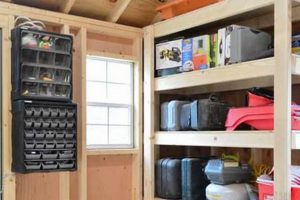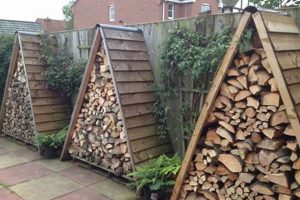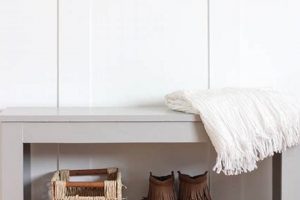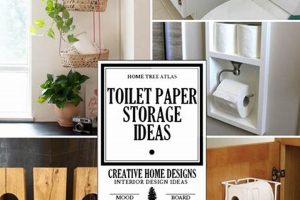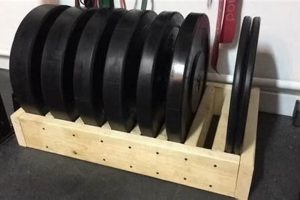A furniture project that integrates a dog’s enclosure into a stylish piece of home dcor, often offering additional space for organization. These projects typically involve building a wooden structure around or incorporating an existing pet kennel, transforming it into a functional surface area. An example would be constructing a cabinet with a built-in opening for the animal’s bed, providing a tabletop surface and drawers for storing pet supplies.
Integrating pet accommodations into household furniture maximizes space utilization and contributes to a more harmonious living environment. Historically, pet housing was often relegated to utilitarian spaces. The modern trend of combining pet needs with aesthetic design reflects an increasing emphasis on pets as integral members of the family. This approach provides both comfort for the animal and a seamless integration of their necessities into the home’s overall design scheme.
The following sections will delve into specific aspects of designing and building such a piece, including material selection, construction techniques, customization options, and safety considerations. These elements are crucial for successfully creating a functional and aesthetically pleasing addition to the home.
Guidance for Integrating Pet Housing into Functional Furniture
The following recommendations serve to facilitate the creation of integrated pet housing that is both practical and aesthetically congruent with the surrounding environment. Careful consideration of these points will contribute to a successful outcome.
Tip 1: Material Selection: Prioritize durable and non-toxic materials. Hardwoods such as maple or oak offer structural integrity and resistance to wear. Ensure any paints, stains, or finishes are explicitly labeled as pet-safe and low-VOC (volatile organic compounds).
Tip 2: Ventilation Considerations: Adequate airflow is essential for the animal’s well-being. Incorporate ventilation grates or strategically placed openings in the structure to prevent stagnant air and maintain a comfortable internal environment.
Tip 3: Size and Space Planning: Accurately measure the pet and the existing crate, if applicable, to determine appropriate dimensions. Allocate sufficient internal space for the animal to stand, turn around, and lie down comfortably. Consider future growth if the animal is still developing.
Tip 4: Structural Integrity: Reinforce joints and stress points with screws, dowels, or metal brackets to ensure the piece’s stability and prevent potential collapse. The structure must safely support the weight of items placed on the tabletop surface.
Tip 5: Access and Cleaning: Design the piece with easy access for cleaning and maintenance. A removable floor or a hinged panel simplifies the removal of debris and allows for thorough sanitation.
Tip 6: Security Measures: Incorporate secure latching mechanisms to prevent the animal from escaping the enclosure. The latch should be robust and difficult for the animal to manipulate.
Tip 7: Aesthetic Integration: Select a design that complements the existing home decor. Consider the style, color palette, and hardware to create a cohesive and visually appealing piece of furniture.
These guidelines emphasize the importance of safety, functionality, and aesthetic integration when creating integrated pet housing. Adhering to these principles will contribute to a comfortable and enriching environment for both the animal and the inhabitants of the home.
The subsequent section will provide a detailed exploration of the construction process, addressing specific challenges and offering practical solutions.
1. Structural Integrity
Structural integrity is a paramount consideration in the design and construction of integrated pet enclosures within furniture. Its assurance directly impacts the safety and well-being of the animal, the longevity of the furniture piece, and the overall functionality of the design.
- Load-Bearing Capacity
The integrated unit must possess sufficient strength to support the weight of items placed on its surface. This is particularly critical for console-style designs intended to accommodate electronic devices, decorative objects, or storage. Failure to adequately calculate and reinforce the structure can lead to collapse, potentially injuring the animal and damaging the contents. Examples include using thicker gauge lumber, implementing reinforcing joinery techniques (e.g., mortise and tenon, dovetail), and incorporating internal supports.
- Joint Stability
The connections between individual components must be robust enough to withstand repeated stresses and strains. Weak or poorly executed joints are prone to failure over time, compromising the integrity of the entire structure. Screws, dowels, glue, and metal fasteners are commonly employed to enhance joint stability. The selection of appropriate fasteners and adhesives is crucial, taking into account the type of materials being joined and the anticipated loads.
- Material Selection
The inherent strength and durability of the chosen materials directly contribute to structural integrity. Hardwoods such as oak and maple offer greater resistance to bending, compression, and impact compared to softwoods like pine. The grade and quality of the materials also play a significant role. Selecting knot-free lumber and ensuring proper drying and seasoning minimize the risk of warping, cracking, or splitting, which can compromise the structure’s integrity.
- Enclosure Security
The structure must prevent the animal from escaping or damaging the enclosure. This necessitates secure latching mechanisms, robust door or gate construction, and the elimination of gaps or weak points that the animal could exploit. The materials used for the enclosure itself must be resistant to scratching, chewing, or other forms of damage. The design should also consider the animal’s size and strength to ensure that the enclosure remains secure under normal conditions.
In summary, structural integrity is not merely an aesthetic consideration but a fundamental requirement for the safe and functional integration of pet enclosures into furniture. Adherence to sound engineering principles, careful material selection, and meticulous construction techniques are essential for ensuring the long-term stability and safety of the unit, providing a secure and comfortable environment for the animal while seamlessly blending into the home’s interior.
2. Ventilation Adequacy
Ventilation adequacy is a crucial design consideration for integrating pet enclosures into furniture pieces. Insufficient airflow can lead to a buildup of stale air, odors, and potentially harmful gases, impacting the animal’s health and well-being. Therefore, the design must prioritize adequate ventilation to maintain a comfortable and hygienic environment for the animal within the enclosure.
- Air Exchange Rate
The rate at which fresh air replaces stale air within the enclosure is a primary factor in ventilation adequacy. A low air exchange rate results in a buildup of pollutants and humidity, while an excessive rate can lead to drafts and temperature fluctuations. The optimal rate depends on factors such as the animal’s size, activity level, and the ambient temperature. Implementing ventilation strategies, such as strategically placed vents or forced-air circulation systems, directly influences the air exchange rate within the integrated enclosure.
- Vent Placement and Design
The location and design of ventilation openings significantly affect airflow patterns within the enclosure. Vents positioned low to the ground can facilitate the removal of heavier-than-air gases, while vents located near the ceiling promote the escape of warm air. The size and shape of the vents also influence the amount of air that can pass through them. For instance, large, open vents provide greater airflow but may compromise the enclosure’s security, whereas smaller, baffled vents offer greater security but may restrict airflow. Proper placement and design of vents contribute significantly to the overall ventilation efficiency of the structure.
- Material Permeability
The materials used in constructing the enclosure can also affect ventilation. Permeable materials, such as certain types of wood or fabric mesh, allow for some degree of natural airflow. Conversely, impermeable materials, such as plastic or metal, restrict airflow and require more intentional ventilation strategies. Selecting appropriate materials with consideration for their permeability properties can contribute to a more naturally ventilated environment within the pet enclosure. Choosing solid woods over composites, for instance, can aid in breathability. However, ensure the wood is treated to prevent absorption of liquids or odors.
- Forced-Air Systems
In certain situations, natural ventilation may be insufficient to maintain adequate air quality within the enclosure. Forced-air systems, such as small fans or air purifiers, can be employed to actively circulate air and remove pollutants. These systems can be particularly beneficial in enclosed spaces with limited natural ventilation or in environments with high levels of airborne allergens or irritants. The selection and placement of forced-air systems must be carefully considered to avoid creating drafts or excessive noise that could disturb the animal.
The aforementioned components of ventilation significantly impact the well-being of animals confined within integrated furniture enclosures. Proper planning and execution of these elements help ensure a healthy environment. Ultimately, balancing adequate ventilation with the aesthetic considerations and security requirements of the furniture design results in a functional and humane living space for the pet.
3. Material Safety
Material safety is a crucial element in the design and construction of integrated pet enclosures, directly impacting the health and well-being of the animal occupying the space. The selection of appropriate materials is, therefore, a primary consideration, demanding careful evaluation of potential risks and benefits.
- Toxicity of Finishes
Paints, stains, and sealants used on the surfaces of the enclosure must be non-toxic and low in volatile organic compounds (VOCs). Animals are susceptible to ingesting these substances through chewing or licking, which can lead to various health problems, including respiratory irritation, gastrointestinal distress, and neurological damage. Water-based finishes and those explicitly labeled as pet-safe are preferable. A real-world example includes the use of linseed oil-based finishes, which, while natural, may still pose a risk if ingested in large quantities. The implication is that meticulous research into the composition and safety certifications of all finishes is essential.
- Wood Treatment Chemicals
If using treated lumber, it is imperative to ensure that the treatment chemicals are safe for animal contact. Some wood preservatives contain arsenic, copper, or other toxic substances that can leach out over time and pose a health hazard. Untreated wood is often a safer alternative, provided it is properly sealed to prevent moisture damage and bacterial growth. The implications of using improperly treated wood are potentially severe, ranging from skin irritation to more serious systemic effects. Therefore, selecting appropriate lumber is an important part of construction of this structure.
- Fabric and Upholstery Considerations
For enclosures incorporating fabric or upholstery elements, the materials should be durable, non-toxic, and resistant to chewing or scratching. Certain synthetic fabrics may contain harmful chemicals or release fibers that can be ingested, leading to digestive problems. Natural fibers like cotton or linen are generally safer options, but should be treated with a non-toxic sealant to prevent staining and odor absorption. In the context of integrated pet enclosures, the implications of improper fabric selection extend beyond aesthetics, impacting the animal’s health and safety. Consider also ease of cleaning of materials.
- Fastener Composition
The composition of screws, nails, and other fasteners should also be considered. Avoid using fasteners containing lead or other toxic metals, particularly in areas accessible to the animal. Stainless steel or other corrosion-resistant materials are preferable, as they are less likely to leach harmful substances over time. While the risk of direct ingestion of fasteners may be low, the potential for long-term exposure through contact warrants careful selection. The implications extend to the overall durability of the structure, as corrosion can weaken fasteners and compromise the enclosure’s integrity.
These material safety considerations are paramount when constructing an integrated pet enclosure. A proactive approach, involving thorough research and careful selection of materials, is essential to mitigate potential risks and ensure a safe and healthy environment for the animal, while maintaining the aesthetic and functional integrity of the furniture piece.
4. Spatial Optimization
Spatial optimization, in the context of combined pet housing and furniture construction, refers to the efficient and effective use of available space to maximize functionality and minimize wasted area. Its successful implementation is critical in integrating a pet’s living space seamlessly into a domestic environment, particularly where space is limited. The principles of spatial optimization guide the design and construction phases to ensure the resulting piece is both practical and aesthetically pleasing.
- Footprint Reduction
Minimizing the overall footprint of the structure is a primary goal of spatial optimization. This involves carefully considering the dimensions of the pet’s enclosure and integrating it into a multi-functional piece of furniture. A common example is combining a dog crate with a console table, eliminating the need for separate, space-consuming entities. The implication is a more streamlined living space with reduced clutter and improved flow.
- Vertical Space Utilization
Exploiting vertical space can significantly enhance the utility of the combined unit. This may involve incorporating shelving, drawers, or cabinets above or around the pet’s enclosure to provide storage for pet supplies, household items, or decorative objects. Examples include building a bookshelf around a cat’s climbing structure or integrating drawers beneath a rabbit hutch. Effective vertical space utilization maximizes storage capacity without expanding the overall footprint of the structure.
- Multi-Functionality
Designing the unit for multiple purposes is a key element of spatial optimization. Beyond simply housing the pet, the structure can serve as a TV stand, a side table, or a room divider. This approach reduces the need for additional furniture pieces and maximizes the utility of the available space. For example, a dog crate console could double as a coffee table, offering both a comfortable den for the pet and a functional surface for everyday use. This also may improve pet acceptance by integrating its personal space into the area the owner spends the most time in.
- Accessibility and Flow
Spatial optimization extends to ensuring easy access to both the pet’s enclosure and the storage areas within the structure. Doors, drawers, and shelves should be designed for convenient use, and the overall layout should promote smooth traffic flow within the room. Examples include incorporating a wide opening for the pet’s entry and exit or positioning shelves at an accessible height. Optimizing accessibility enhances the functionality of the unit and improves the overall living experience.
These facets of spatial optimization contribute to the creation of a harmonious and efficient living environment. By carefully considering the footprint, vertical space utilization, multi-functionality, and accessibility, it is possible to seamlessly integrate pet housing into functional furniture, maximizing the utility of available space and enhancing the overall aesthetic of the home.
5. Accessibility
Accessibility, in the context of integrated pet housing and furniture projects, denotes the ease with which both the animal and the human caretaker can interact with the structure. This consideration encompasses various aspects, from the pet’s ability to enter and exit the enclosure freely to the owner’s capacity to clean and maintain the space effectively. Accessibility directly influences the comfort, safety, and hygiene of the pet, as well as the practicality and longevity of the furniture piece. A dog crate integrated into a console table, for instance, must feature an appropriately sized opening for the dog to navigate without difficulty. Conversely, an insufficient opening could cause anxiety or physical injury to the animal.
Effective accessibility also extends to the maintenance of the enclosure. A removable floor or easily accessible panels simplify the process of cleaning up messes and sanitizing the interior, preventing the buildup of odors and bacteria. Storage compartments integrated into the design should be readily accessible to the owner for storing and retrieving pet supplies, such as food, toys, and grooming tools. Examples of poor accessibility design include enclosures with small, awkwardly placed openings that are difficult for the animal to enter or exit, or storage areas that are hard to reach and organize. The consequences of such designs range from inconvenience and frustration to potential safety hazards for the pet.
In summation, prioritizing accessibility in the design and construction of integrated pet housing is essential for ensuring the animal’s well-being and the owner’s convenience. Challenges in achieving optimal accessibility often stem from balancing aesthetic considerations with practical needs. However, a thorough understanding of the animal’s physical capabilities and the owner’s maintenance requirements can guide the creation of functional and aesthetically pleasing designs that meet the needs of both pet and owner. This approach contributes to a harmonious living environment and reinforces the human-animal bond.
Frequently Asked Questions Regarding Integrated Pet Enclosures
The following section addresses common inquiries and concerns related to the design, construction, and functionality of integrated pet enclosures, providing concise and informative answers to guide prospective builders and owners.
Question 1: What types of animals are best suited for integrated crate furniture?
Small to medium-sized dogs and cats are typically well-suited for integrated crate furniture. Animals that are already crate-trained and comfortable spending time in enclosed spaces will adapt more easily to this type of accommodation. Animals with destructive chewing habits may not be suitable due to the potential for damage to the furniture.
Question 2: How can proper ventilation be ensured in an enclosed pet crate?
Adequate ventilation can be achieved by incorporating strategically placed vents or openings in the structure. The size and placement of these vents should allow for sufficient airflow without compromising the security of the enclosure. Forced-air systems, such as small fans, may be necessary in particularly enclosed spaces.
Question 3: What materials are safest for constructing an integrated pet crate?
Durable, non-toxic materials are essential for constructing a safe pet crate. Hardwoods, such as maple or oak, are often preferred for their strength and resistance to wear. Any paints, stains, or sealants used should be explicitly labeled as pet-safe and low in volatile organic compounds (VOCs).
Question 4: How should the size of the crate be determined for the animal?
The crate should be large enough to allow the animal to stand, turn around, and lie down comfortably. Measure the animal’s height, length, and width to determine the minimum dimensions required. Consider future growth if the animal is still developing.
Question 5: How can the risk of escape be minimized?
Secure latching mechanisms and robust door or gate construction are essential for preventing escape. The latch should be difficult for the animal to manipulate, and the enclosure should be free of gaps or weak points that the animal could exploit. Regular inspection of the enclosure for signs of damage or wear is also recommended.
Question 6: What cleaning and maintenance procedures are recommended for an integrated pet crate?
Regular cleaning is essential for maintaining a hygienic environment within the crate. A removable floor or hinged panel simplifies the removal of debris and allows for thorough sanitation. Use pet-safe cleaning products to avoid exposing the animal to harmful chemicals. Periodic inspection for signs of damage or wear is also recommended.
These answers provide a foundational understanding of key considerations when planning and executing an integrated pet enclosure project. Prioritizing safety, functionality, and the animal’s well-being will contribute to a successful and harmonious integration of pet housing into the home environment.
The subsequent section will explore advanced design considerations and customization options for integrated pet enclosures.
Concluding Observations
The preceding discussion has provided a comprehensive overview of the key considerations involved in creating a dog crate console diy with storage. It underscores the importance of structural integrity, ventilation, material safety, spatial optimization, and accessibility. Success hinges on a meticulous approach to design and construction, prioritizing the animal’s well-being and integrating the piece seamlessly into the home.
The creation of integrated pet accommodations requires careful planning and execution, yet the benefits of combining functionality and aesthetics are undeniable. A thoughtfully designed unit enhances the living space, providing a comfortable and secure environment for the animal while serving a practical purpose within the home. Those undertaking such a project are encouraged to approach it with diligence and a commitment to both form and function. The result will be a harmonious addition to the household.


